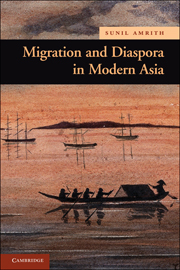Book contents
- Frontmatter
- Contents
- List of Plates, Tables, and Maps
- Acknowledgements
- Select Timeline
- Glossary
- Maps
- Introduction
- 1 Asia's Great Migrations, 1850–1930
- 2 The Making of Asian Diasporas, 1850–1930
- 3 War, Revolution, and Refugees, 1930–1950
- 4 Migration, Development, and the Asian City, 1950–1970
- 5 Asian Migrants in the Age of Globalization, 1970–2010
- Conclusion
- Guide to Further Reading
- Index
2 - The Making of Asian Diasporas, 1850–1930
Published online by Cambridge University Press: 05 June 2012
- Frontmatter
- Contents
- List of Plates, Tables, and Maps
- Acknowledgements
- Select Timeline
- Glossary
- Maps
- Introduction
- 1 Asia's Great Migrations, 1850–1930
- 2 The Making of Asian Diasporas, 1850–1930
- 3 War, Revolution, and Refugees, 1930–1950
- 4 Migration, Development, and the Asian City, 1950–1970
- 5 Asian Migrants in the Age of Globalization, 1970–2010
- Conclusion
- Guide to Further Reading
- Index
Summary
diaspora noun 3. The dispersion or spread of any people from their original homeland; 4. People who have spread or been dispersed from their homeland DERIVATES: diasporic adj. Oxford English Dictionary
Long used exclusively in relation to the Jewish Diaspora (and later encompassing the African experience of slavery), the term ‘diaspora’ has undergone a significant expansion in its usage and definition. At its most imprecise, diaspora has become synonymous with migration; almost any migrant group is now labelled a diaspora. The term is more useful, however, when it draws our attention specifically to the kinds of connections migrants maintain with their homelands and with others of shared origin dispersed around the world. ‘Diaspora’ can be used to describe a process of migration and dispersal, and also the condition of living in diaspora – that is to say, a form of consciousness that arises from the experience of migration and exile.
Contemporary discussions of diaspora draw heavily on the recent experience of diasporas in the multi-cultural democracies of Western Europe, and especially North America. This chapter shows that the formation of Asian diasporas within Asia developed from the distinctive characteristics of Asian migration in the nineteenth and early-twentieth centuries (Chapter 1): the relative proximity between homelands and destinations; the dominance of sojourning or circular migration; the relative absence of women; the sheer scale of the movement.
- Type
- Chapter
- Information
- Migration and Diaspora in Modern Asia , pp. 57 - 88Publisher: Cambridge University PressPrint publication year: 2011



